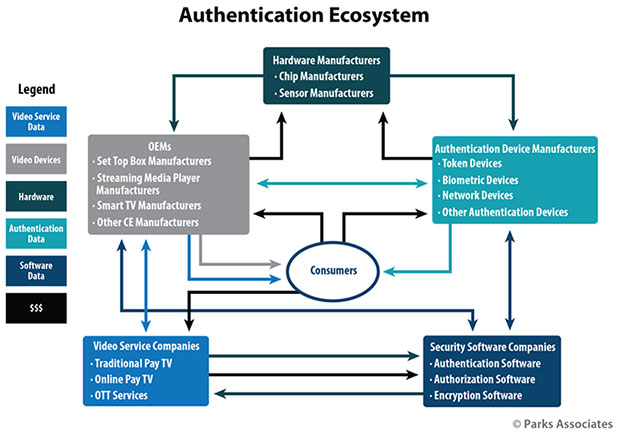New personal identification and authentication technologies have the potential to transform the way entertainment services are delivered, accessed and experienced. These technologies offer a high level of security, often incorporating biometrics such as voice, fingerprint, iris or retinal features, and facial characteristics.
The development of authentication technologies for video entertainment in the coming years is likely to come from combinations of the following authentication methods:
- Passwords
- Physical security keys
- Voice control
- Single-factor biometrics
- Multifactor biometrics
- Behavioral biometrics
- Geographic factors
Each type of authentication bears its own advantages and disadvantages, which prevents any one authentication type from becoming dominant. Certainly, there was a time when passwords dominated authentication, but as security systems became more complex, other technologies took hold.
The future of authentication is to blend multiple methods in the most frictionless manner possible, in order to create a seamless authentication process for consumers.
Areas of Innovation in Authentication
A leading area of innovation is in adaptive authentication. This technology determines the level of authentication needed for a given interaction with a service. So, each interaction comes with a specified level of authentication that best fits the level of the transaction, balancing effective security with degree of inconvenience for users.
With adaptive authentication, each interaction with a device and service is effectively graded for its normalcy, based on prior user behavior. Data points like geography, time, and watching behavior are taken into consideration to determine this grade. Grading ensures that interactions that need a high level of security receive it while routine interactions allow users a frictionless experience.
In order to make adaptive authentication work, current authentication methods must be layered on top of each other. Layered authentication will use various methods, based on the grading that occurred during the adaptive authentication process.
Adaptive authentication provides distinct advantages over traditional authentication because it treats every interaction differently, providing proper levels of security, frictionless experience, and reduction of consumer time to content, improving the user experience.
The evolution of adaptive authentication will bring not only a more personalized approach to authentication, but also a more secure one. This progress will require advancements in the approach to authentication with regard to technology, software, and user behavior models.
Key Innovation Factors and Requirements
While the technology exists now for adaptive authentication to work across most devices, the ecosystem of authentication remains remarkably fragmented. Across video services, there is no industry standard for unifying a subscriber’s services across a variety of devices.

Additionally, AI technologies still need multiple inputs from the majority of consumers before they are viable for use across all services.
The development of these factors for adaptive authentication affects the adoption of layered authentication because it determines what methods of authentication are best used for a given interaction or login.
Layered authentication can function properly only if adaptive authentication is in place. Without a system to determine the normalcy of a given interaction, layered authentication provides a hindrance to user experience, as it incorporates additional layers of authentication with no consideration for the security concerns associated with a particular login. This slows the time to content, although speed to content is an important goal for entertainment-related authentication.
The future of these two methods of authentication, adaptive and layered, is promising. Today’s consumers increasingly are informed about data security measures, and with devices having more sensors, enabling differing layers of authentication is becoming increasingly popular.
Future Authentication Use Cases
The growth of various authentication technologies, as well as the deployed methods of adaptive and layered authentication, impacts ways in which a specific technology can be used. For authentication, changing technology and deployment methods present interesting implementations for connected entertainment device ecosystems and consumers subscribing to multiple online video services.
Stakeholders in authentication see the development of these connected device ecosystems and the growing market for Internet video services as catalysts for the development of authentication technology. Companies like CasteOS have capitalized on this, taking advantage of the increased number of required logins to provide value for consumers in a platform-agnostic smart home management system.
Its proprietary OS simplifies in-home authentication for users and can be applied to decentralized ecosystems in the future. Regardless of which scenario plays out for device ecosystems and which technologies emerge, the explosion in the number of logins required across devices and services has disrupted authentication.
Impact of Authentication on Personalization
Improvements in authentication deliver greater accuracy in identifying users and better contextual information about the environment, devices and services present when consumers access content. As a result, devices or services performing authentication can leverage this information to deliver enhanced entertainment experiences.
Overall, consumers ultimately will enjoy a unified experience that combines the capabilities of all their devices, and allows them to access each of their video subscriptions across them. While advanced authentication features may drive consumer fears, users easily can understand the personal benefit of increased personalization.
Barriers to Mainstream Adoption
The future of authentication and personalization begins with passwords. Passwords represent not only the most popular method of authentication for consumers, and the one with which they are most familiar. Nearly every legacy system of authentication involves some form of username and password to login. However, as those systems grow antiquated, new methods of authentication will take a foothold in the market.
The barriers for adoption for new methods of authentication include the expense of new technology, consumer fears about data or identity theft, and consumers’ lack of familiarity with authentication types. While each of these factors represents an obstacle to authentication and personalization, none presents an insurmountable challenge for the technological leaders in the industry.
Increased use of technology inevitably will lead to innovation, especially in authentication and personalization, where new sensors, software and algorithms likely will spur the development and adoption of new technology.














































Social Media
See all Social Media